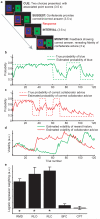Associative learning of social value
- PMID: 19005555
- PMCID: PMC2605577
- DOI: 10.1038/nature07538
Associative learning of social value
Abstract
Our decisions are guided by information learnt from our environment. This information may come via personal experiences of reward, but also from the behaviour of social partners. Social learning is widely held to be distinct from other forms of learning in its mechanism and neural implementation; it is often assumed to compete with simpler mechanisms, such as reward-based associative learning, to drive behaviour. Recently, neural signals have been observed during social exchange reminiscent of signals seen in studies of associative learning. Here we demonstrate that social information may be acquired using the same associative processes assumed to underlie reward-based learning. We find that key computational variables for learning in the social and reward domains are processed in a similar fashion, but in parallel neural processing streams. Two neighbouring divisions of the anterior cingulate cortex were central to learning about social and reward-based information, and for determining the extent to which each source of information guides behaviour. When making a decision, however, the information learnt using these parallel streams was combined within ventromedial prefrontal cortex. These findings suggest that human social valuation can be realized by means of the same associative processes previously established for learning other, simpler, features of the environment.
Figures




References
-
- Fehr E, Fischbacher U. The nature of human altruism. Nature. 2003;425:785–91. - PubMed
-
- Maynard Smith J. Evolution and the Theory of Games. Cambridge Univ. Press; 1982.
-
- Delgado MR, Frank RH, Phelps EA. Perceptions of moral character modulate the neural systems of reward during the trust game. Nat Neurosci. 2005;8:1611–8. - PubMed
-
- King-Casas B, et al. Getting to know you: reputation and trust in a two-person economic exchange. Science. 2005;308:78–83. - PubMed
-
- Rilling J, et al. A neural basis for social cooperation. Neuron. 2002;35:395–405. - PubMed
Publication types
MeSH terms
Grants and funding
LinkOut - more resources
Full Text Sources
Other Literature Sources

